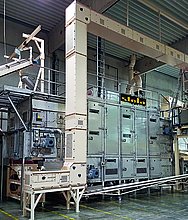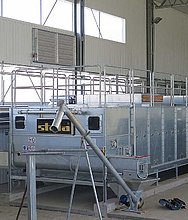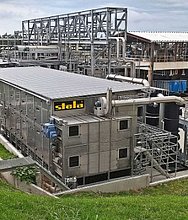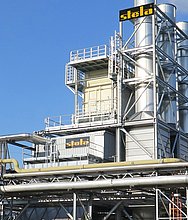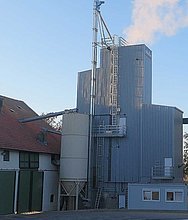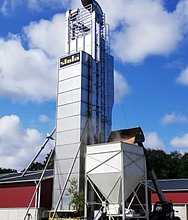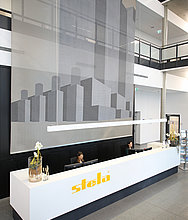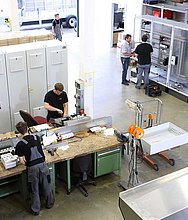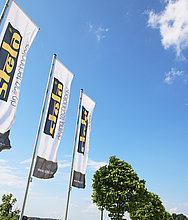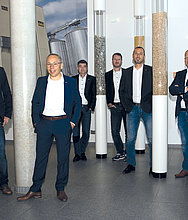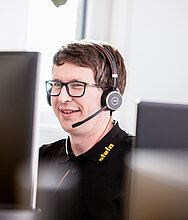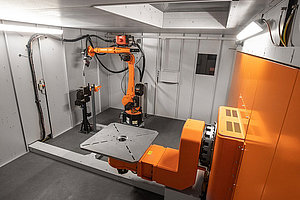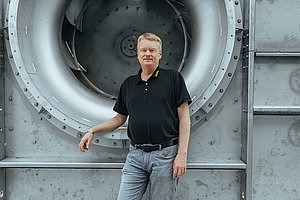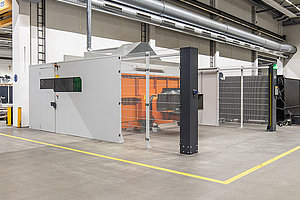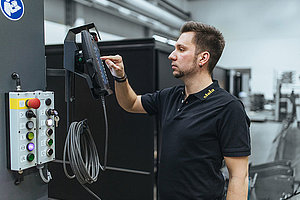Welding and system engineering is what Stela Laxhuber, a hidden champion of industrial drying technology, is all about. Now, with the innovative Kuka Cell4_Production robotic cell, the Massing-based company is breaking new ground in the welding of fans for drying systems. In doing so, they demonstrate how small and medium-sized enterprises can benefit from robotics and automation.
Nothing is more powerful than an idea whose time has come. Or at least, that’s what French author Victor Hugo is supposed to have said. But is this really true? Searching for evidence leads to Lower Bavaria on the outskirts of Massing. Here, five years ago, Stela Laxhuber GmbH restructured its administrative and production units on a state-of-the-art industrial site.
The family business, now in its third generation and managed by Thomas Laxhuber, is a “hidden champion”. With 235 employees, the plant manufacturer Stela – named after its founder Stefan Laxhuber – designs and manufactures sophisticated drying technology of all sizes and for all fields of application for customers from all over the world. Customers come from the agricultural industry, wood-based materials processing, the food, animal feed, cellulose and paper industries as well as the water industry.
Dryin on a large scale
At the heart of these drying systems are huge fans that extract moisture from products such as grain, maize, wood or recycled plastic with warm air. The fan wheels in the dryers can be up to 1.60 m in diameter and weigh up to half a tonne. When something of such colossal size is accelerated to up to 3,000 revolutions per minute, every component must be flawless.
“The special thing about Stela is the high level of vertical integration,” explains Thomas Laxhuber, who took over in 2014 to become the third generation of family management. “To continue producing world-leading drying technology, we strive to manufacture the essential components of our machines in-house as much as possible.” This is particularly important for highly stressed components such as the fan wheels. These radial fans are similar to a rotating drum. Their curved blades suck in the air over the motor axis and blow it out again at an angle of 90°.
False start
Stela started looking for automation solutions for fan assembly 25 years ago. “We wanted to restructure our welding department using other types of robots,” says Thomas Laxhuber. “But the experiment was a complete failure. The robots were unable to provide any real help with demanding welding tasks, created more problems than they solved, and virtually all employees rejected them. The idea was good, but it wasn’t the right time. So, we got rid of the robots again.”
Today, Andreas Utz stands with a smart pad in front of an approximately 40 m2 container-like enclosure in the production hall and looks in through the dark green protective glass pane. The production manager for fan construction at Stela is controlling the brand-new cell4_arc robot cell from Kuka. Inside, blue sparks spray through the air. The six-axis KUKA KR Cybertech shielded arc welding robot moves rhythmically, using its slender orange arm to guide the sensor-controlled torch to the fan drum.
Tricky millimetre work
Before starting, Andreas Utz had attached the blades to the housing by hand using spot welds and screwed the steel construction in place on the positioner. Once the positioning unit had been swivelled into the interior of the cell, an intelligent line laser scanned the component using Kuka Seamtech Finding to determine the optimal starting point for the torch. Then the precision work could begin. Seam after seam – always with the same precision choreographed by the Kuka Arcsense software.
In about 50 minutes, the radial fan is welded and ready for balancing and painting. As the finished workpiece leaves the cell, the next workpiece rotates in, having already been screwed onto the other side by Andreas Utz. “Manual welding takes about a day,” says Andreas Utz. “With the robot cell, we are in the fast lane. Both in terms of time and quality. The seams are welded so perfectly in a short space of time in a way that would never be possible by hand. Now we can produce quantities that we never dreamed of and have been able to manage the volume of orders again.”
Robot suppliers dismiss idea
The path to achieving such a reduction in workload was less simple than operating the cell. Sven Pietsch still remembers very well the dismissive reactions of robot suppliers when Stela's purchasing manager, together with managing director Thomas Laxhuber, set out to launch a new attempt at automation after 25 years. “We were under pressure,” recalls Pietsch. “The order books were full. And at the same time, it was becoming increasingly difficult to find suitable skilled workers for our demanding but also relatively monotonous welding work in large-scale production.”
The Bavarians sought suitable solutions for their requirements at various trade fairs, but without success. “Apparently they considered us too insignificant as a medium-sized company,” says Sven Pietsch with a smile. But then he met the Kuka experts at the Euroblech trade fair in Hanover. “We quickly began talking about a custom solution for our challenge. We were on the same page straight away and began to discuss it in-depth.”
Made-to-measure cell concept
So began a learning process for all involved. At Kuka’s Techcenter for Welding Applications, they dove deep into Stela’s production processes to configure a Cell4_arc robotic cell perfectly tailored to fan production from various standard hardware and software modules. “We could feel all the way through that we were working with the right people and the right technology at the right time and in the right place,” comments Thomas Laxhuber.
The robot cell for Stela also showcases Kuka’s new approach to customised, modular automation steps. “With our intelligent Kuka Cell4_Production concept, we can combine optimally coordinated components and proven standards from the field of shielded arc welding to create ideal solutions in welding automation,” says Mathias Klaus, who is responsible for Solution Sales Modular Cell Business at Kuka. “With the right application software, handling and programming the welding parameters are as simple as possible. This allows us to meet the highest production demands. The robotic cell we developed together with Stela is impressive evidence of this.”
Thomas Laxhuber is also impressed. “For almost 100 years, it has been part of Stela’s DNA to be guided by quality in the world of drying and to always be one step ahead in terms of technology.” Sometimes an idea needs 25 years to mature before it is able to achieve its full potential in the right partnership at the right time.
Kuka Deutschland GmbH
Zugspitzstraße 140
86165 Augsburg
www.kuka.com
See the video at: https://youtu.be/D7eNw8OWbNg
Source: Automationspraxis ( Kukas innovative Roboterzelle schweißt bei Stela Ventilator-Kolosse (industrie.de) )











